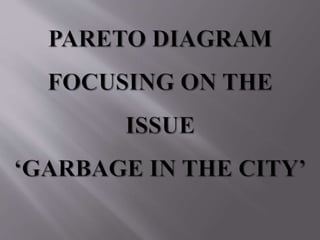Qcl 15-v4 challenge no. 4-institute of management, nirma university_krishan kant goyal
•Download as PPTX, PDF•
0 likes•230 views
The document discusses Pareto charts and their use in identifying the most important sources of problems or causes. It then provides an example Pareto chart analyzing sources of garbage in a city. The chart shows that the top 5 sources - Paper and Paperboard, Food Scrap, Yard Trimmings, Plastics, and Metals - account for over 50% of the garbage. Therefore, focusing efforts on these top sources would be most effective in reducing the overall garbage in the city.
Report
Share
Report
Share

Recommended
Recommended
More Related Content
Similar to Qcl 15-v4 challenge no. 4-institute of management, nirma university_krishan kant goyal
Similar to Qcl 15-v4 challenge no. 4-institute of management, nirma university_krishan kant goyal (20)
Sustainable Water Management Powerpoint Presentation Slides

Sustainable Water Management Powerpoint Presentation Slides
Water Sector Analysis PowerPoint Presentation Slides

Water Sector Analysis PowerPoint Presentation Slides
Implementation of ETP & effect of Textile waste water on environment 

Implementation of ETP & effect of Textile waste water on environment
Dyes and Pigments Manufacturing Industrial Waste Water Treatment Methodology

Dyes and Pigments Manufacturing Industrial Waste Water Treatment Methodology
FRAC DESIGN IMPACTS TO PRODUCTION, ACTIVITY, AND HISTORY

FRAC DESIGN IMPACTS TO PRODUCTION, ACTIVITY, AND HISTORY
Water Quality Assessment Powerpoint Presentation Slides

Water Quality Assessment Powerpoint Presentation Slides
Qcl 14-v3 pareto-diagram_bansthali_univercity_astha_srivastava

Qcl 14-v3 pareto-diagram_bansthali_univercity_astha_srivastava
Groundwater Management Powerpoint Presentation Slides

Groundwater Management Powerpoint Presentation Slides
More from Krishna Goyal
More from Krishna Goyal (6)
Qcl 15-v4 challenge no. 5-institute of management, nirma university_krishan k...

Qcl 15-v4 challenge no. 5-institute of management, nirma university_krishan k...
Qcl 15-v4 challenge no. 5-institute of management, nirma university_krishan k...

Qcl 15-v4 challenge no. 5-institute of management, nirma university_krishan k...
Qcl 15-v4 challenge no. 5-institute of management, nirma university_krishan k...

Qcl 15-v4 challenge no. 5-institute of management, nirma university_krishan k...
Qcl 15-v4 challenge no.3-institute of management, nirma university_krishan ka...

Qcl 15-v4 challenge no.3-institute of management, nirma university_krishan ka...
Qcl 15-v4 challenge no. 2-institute of management, nirma university_krishan k...

Qcl 15-v4 challenge no. 2-institute of management, nirma university_krishan k...
Qcl 15-v4 challenge no. 1-institute of management, nirma university_krishan k...

Qcl 15-v4 challenge no. 1-institute of management, nirma university_krishan k...
Qcl 15-v4 challenge no. 4-institute of management, nirma university_krishan kant goyal
- 2. • Introduction to Pareto Diagram • Stratification of Symptoms • Identification of Sources • Problem Definition • Learning’s
- 3. • A pareto chart, also called a pareto distribution diagram, was named after vilfredo pareto has both lines graph and bars. • The bars represent the individual values in the decreasing order from left to right and the line represents the cumulative total. • The pareto chart provides a graphic depiction of the pareto principle, which states that 80% of the output is produced by 20% of the input.
- 4. • In simple words 80% of total problems are caused by only 20% of input factors. • Applications of Pareto Chart: Used to analyze data about the frequency of problems or causes in a process. Used when there are many problems or causes and you want to focus on the most significant. Used while analyzing broad causes by looking at their specific components.
- 5. SURFACE WATER CONTAMINATION Waste that end up in water bodies negatively change the chemical composition of the water. Technically, this is called water pollution. This will affect all ecosystems existing in the water. It can also cause harm to animals that drink from such polluted water. SOIL CONTAMINATION Hazardous chemicals that get into the soil (contaminants) can harm plants when they take up the contamination through their roots. If humans eat plants and animals that have been in contact with such polluted soils, there can be negative impact on their health. POLLUTION Bad waste management practices can result in land and air pollution and can cause respiratory problems and other adverse health effects as contaminants are absorbed from the lungs into other parts of the body. LEACHATE Liquid that forms as water trickles through contaminated areas is called Leachate. It forms very harmful mixture of chemicals that masy result in hazardous substances entering surface water, groundwater or soil. STRATIFICATION OF SYMPTOMS
- 6. Residential Industrial Commercial Institutional Construction and Demolition Agriculture Municipal Services Manufacturing
- 7. 28.50% 13.90% 13.40% 12.40% 9.00% 8.40% 6.40% 4.60% 3.40% Sources of Garbage in the City Paper and Paperboard Food Scrap Yard Trimmings Plastics Metals Rubber, Leather & Textiles Wood Glass Others
- 9. • Hence, now we have those sources which accounts for 80% of garbage in the city and which needs to be focused. Paper and Paperboard Food Scrap Yard Trimmings Plastics Metals
- 10. • Heavy and light manufacturing, refineries, chemical plants, power plants, mineral extraction and processing. Manufacturing • Light and heavy manufacturing, fabrication, construction sites, power and chemical plants. Industrial • Street cleaning, landscaping, parks, beaches, other recreational areas, water and wastewater treatment plants. Municipal Services
- 11. • 'Schools, hospitals, prisons, government centres.Institutional • New construction sites, road repair, renovation sites, demolition of buildings. Construction & Demolition • Crops, orchards, vineyards, dairies, feedlots, farms.Agriculture •Single and multifamily dwellings.Residential •Stores, hotels, restaurants, markets, office buildings, etc.Commercial
- 12. We learned the concept of ‘vital few and the useful many’, according to which one need to focus on those 20% factors which contribute to the 80% of the output. We came to know about the major source of pollution and garbage in the city. We also realized on which factors we need to focus in order to lower down the garbage level in the city.
- 13. We realized how important is ‘Pareto Chart’ as a quality tool. Very helpful in decision making. Pareto Analysis not only shows us the most important problem to solve, it also gives us a score showing how severe the problem is.